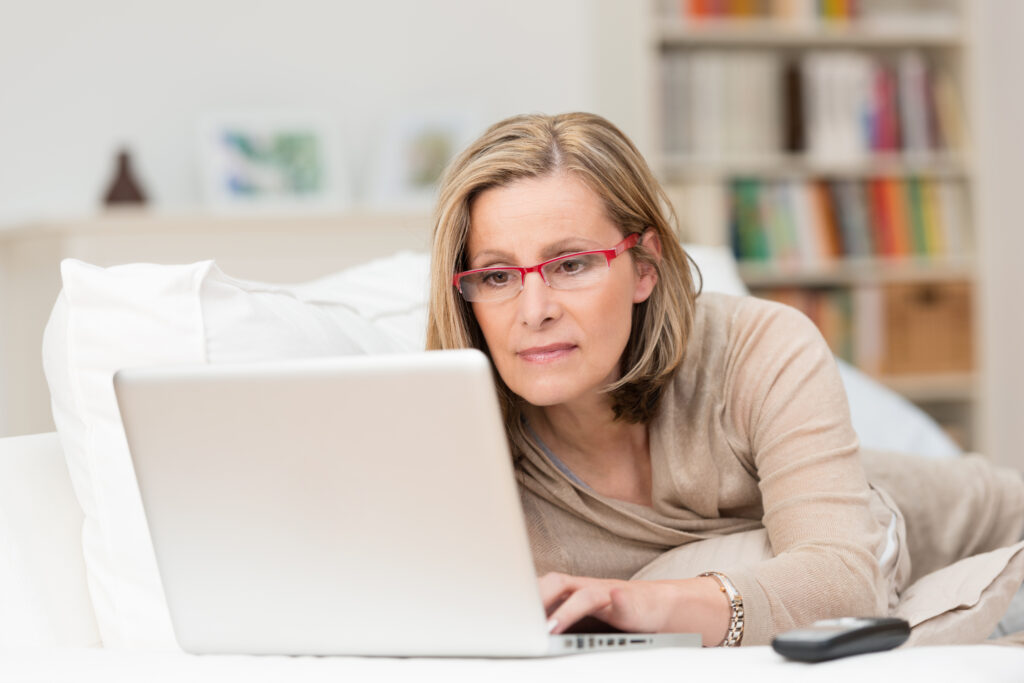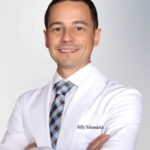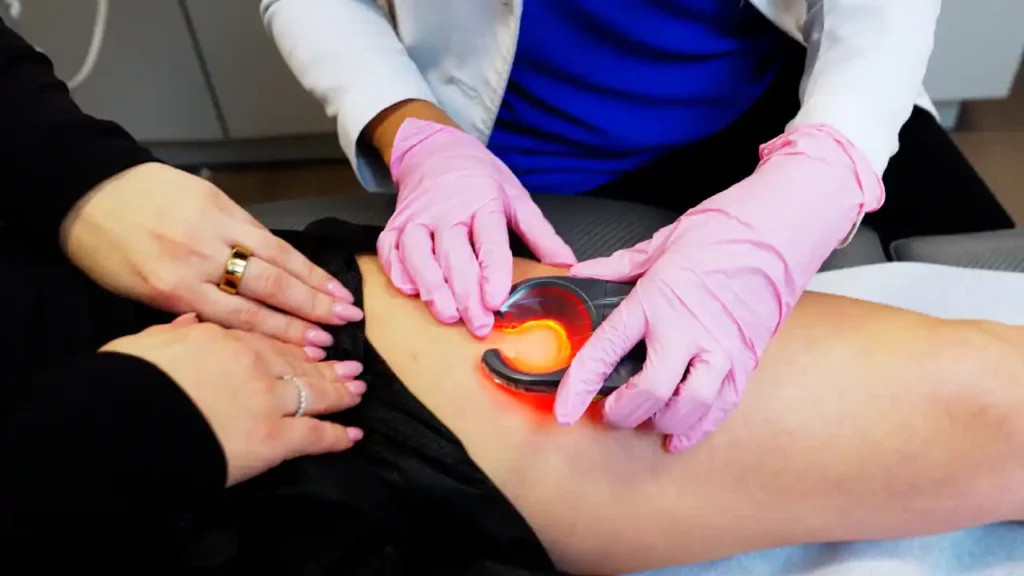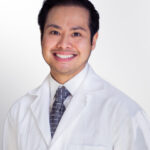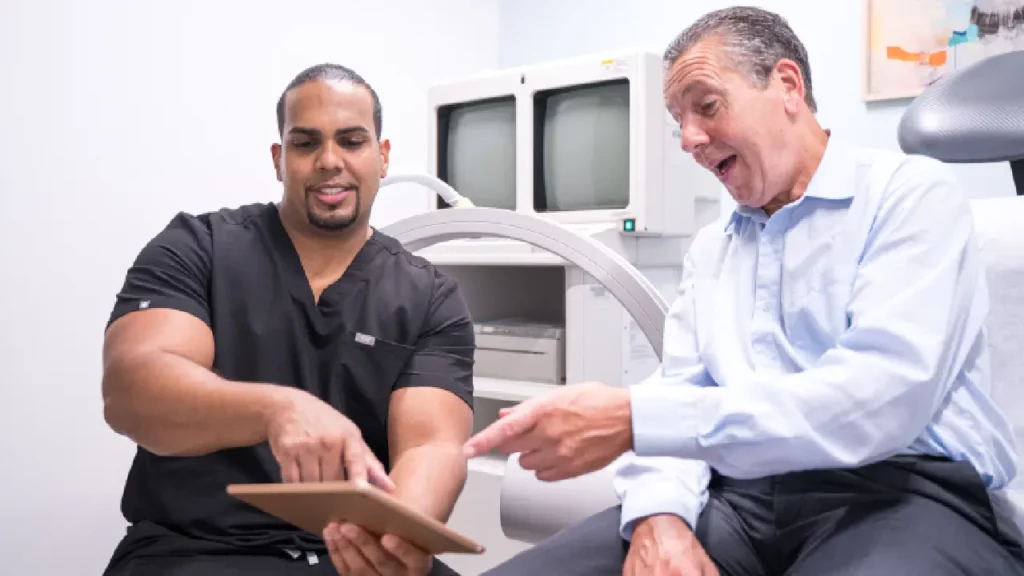A Comprehensive Guide to Varicose Veins: Causes, Symptoms, Diagnosis, Treatments, and More
Are you or someone you know struggling with the discomfort and unsightly appearance of varicose veins? Varicose veins affect millions worldwide, but few truly understand what they are, their consequences, and the available treatments.
In this guide to varicose veins, we explore the various factors contributing to the development of varicose veins, the telltale signs and symptoms, and how vein doctors diagnose and treat this condition. We’ll describe the available vein treatment modalities, from lifestyle changes and conservative methods to advanced minimally invasive varicose vein treatments. We’ll also provide tips and strategies to identify your risk factors and reduce the risk of varicose veins, so you have all the information needed to make informed decisions about your vascular health.
Vein Treatment Clinic is a state-of-the-art medical center specializing in cutting-edge, minimally invasive varicose vein treatments. Our board-certified vein doctors carefully examine your leg veins, discuss your symptoms, and curate personalized vein treatment plans. Instead of simply treating visible varicose veins, we diagnose and treat the root causes of varicose veins to ensure safe, consistent, and long-lasting results with a minimal risk of vein disease recurrence. You can find our vein treatment clinics in New York City, Long Island, New Jersey, Maryland, and California — please schedule an appointment at your nearest vein treatment clinic.
What Are Varicose Veins?
Varicose veins are enlarged, twisted veins that typically appear in the legs and sometimes other areas of the body. They look like dense masses of twisted, tangled, and knotted rope-like veins bulging from the skin’s surface. They develop when the valves within the veins weaken or malfunction, causing blood to pool and veins to swell. Varicose veins are often characterized by a blue or purple appearance, and they can lead to discomfort, pain, and various symptoms.
Are you interested in getting more information about your condition or a treatment?
Fill the form below to start!
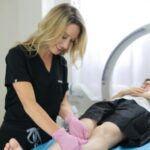
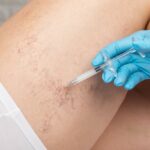

What Are the Signs & Symptoms of Varicose Veins?
The most obvious signs of varicose veins are dense, knotted, bulging veins on the legs or lower extremities of the body. However, varicose veins are accompanied by other symptoms that affect your life, such as heaviness and leg cramps. These are some of the most common signs and symptoms of varicose veins:
- Visible swollen, twisted veins
- Aching or throbbing in the legs
- Heaviness or discomfort in the legs
- Swelling, especially in the ankles and feet
- Itching or burning sensations
- Frequent leg cramps
- Skin discoloration or darkening around the veins
- Restless leg syndrome
- Pain worsened after prolonged standing or sitting
It’s important to note that not everyone with varicose veins will experience all of these symptoms, and some individuals may only have cosmetic concerns without significant discomfort. If you suspect you have varicose veins or are experiencing any of these symptoms, please consult our vein doctors for a proper evaluation and guidance on treatment options.
What Is the Root Cause of Varicose Veins?
The root cause of varicose veins is often attributed to a condition known as chronic venous insufficiency. CVI occurs when the valves in the veins of the legs weaken or become damaged. These valves are responsible for ensuring that blood flows upward toward the heart. When they malfunction, blood can flow backward and pool in the veins, leading to their enlargement and the development of varicose veins. Other factors, such as genetics, hormonal changes, and prolonged standing or sitting, can also contribute to the development of varicose veins.
What Is Chronic Venous Insufficiency?
To understand chronic venous insufficiency (CVI), it’s essential to grasp how normal veins function. The human body consists of two types of blood vessels: arteries and veins. The arteries carry oxygenated blood from the heart to various body parts, and the veins carry deoxygenated blood back to the heart. Healthy veins have one-way valves that facilitate the return of blood from the extremities to the heart. These valves open to allow blood to flow upward and then close to prevent it from flowing backward.
Chronic venous insufficiency is a condition in which the vein valves become weakened or damaged. The vein valves may weaken or malfunction for numerous reasons, such as age, trauma, genetic predisposition, pregnancy, etc. When vein valves weaken or malfunction, they fail to close properly, causing blood to reflux or flow backward and pool within the veins. This pooling of blood increases pressure within the veins, leading to their dilation and enlargement, ultimately giving rise to varicose veins, spider veins, and other vein problems.
What Are the Risk Factors for Varicose Veins?
Varicose veins generally occur when the vein valves malfunction or weaken. Understanding your risk allows you to take proactive measures to make lifestyle changes that can reduce the risk of vein disease. These are some of the risk factors for varicose veins:
- Age: Varicose veins become more prevalent as individuals age because the veins and valves in the legs naturally undergo wear and tear over time. The gradual loss of elasticity in the veins can lead to their dilation and the development of varicosities.
- Family History: A family history of varicose veins suggests a genetic predisposition to the condition. If your parents or close relatives have had varicose veins, you may have inherited a greater likelihood of developing them due to shared genetic factors.
- Gender: Women are statistically more prone to varicose veins than men. Hormonal fluctuations, particularly those associated with pregnancy and hormonal contraception, can weaken vein walls and valves, making women more susceptible.
- Pregnancy: During pregnancy, the growing uterus exerts increased pressure on the pelvic blood vessels and the veins in the legs. Additionally, hormonal changes, including elevated levels of progesterone, can relax vein valves, increasing the risk of vein disease.
- Obesity: Excess body weight places additional stress on the veins in the lower body, making it harder for blood to flow upward against gravity. This added pressure can lead to the development of varicose veins and other vein problems.
- Sedentary Lifestyle or Occupation: Occupations or activities that require long periods of standing or sitting without adequate breaks can hinder proper blood circulation. Over time, this stagnation can contribute to the formation of varicose veins as the blood pools in the legs.
- Hormonal Changes: Hormonal changes, such as those occurring during puberty, menopause, or as a result of taking birth control pills, can influence vein health. Fluctuating hormone levels may affect the elasticity of vein walls and valves.
- Injuries or Trauma: Injuries to the legs, especially those that damage veins or vein valves, can increase the likelihood of developing varicose veins. Trauma may impair the normal functioning of the circulatory system in the affected area.
- Deep Vein Thrombosis (DVT): A history of deep vein thrombosis (blood clots in the deep veins) can damage vein valves and impair blood flow. This can increase the risk of varicose veins as the veins struggle to efficiently return blood to the heart.
- Tight Clothing or High Heels: Wearing tight clothing that restricts blood flow or high-heeled shoes that alter posture can hinder circulation in the legs. This can increase pressure on the veins and contribute to the formation of varicose veins over time.
What Are the Long-Term Complications of Untreated Varicose Veins?
Varicose veins are caused by venous insufficiency, a chronic condition that worsens with time. If left untreated, blood will continue accumulating in the leg veins, eventually leading to numerous long-term risks and medical complications. These are some of the potential long-term complications of untreated varicose veins and venous insufficiency:
- Skin Changes & Discoloration: Over time, untreated varicose veins can lead to skin changes, such as darkening or inflammation around the affected veins. This can result from chronic inflammation and increased pressure in the veins.
- Venous Ulcers: The persistent high pressure in varicose veins can damage the skin, leading to the development of venous ulcers. These are painful, slow-healing sores that typically form on the lower legs and can be challenging to treat.
- Superficial Thrombophlebitis: Varicose veins are prone to inflammation and the formation of blood clots within the affected veins, a condition known as superficial thrombophlebitis. This can cause localized pain, swelling, and redness.
- Deep Vein Thrombosis (DVT): In some cases, untreated varicose veins can contribute to the development of deep vein thrombosis (DVT). DVT is a serious condition where blood clots form in the deeper veins of the legs, potentially leading to life-threatening complications if the clot dislodges and travels to the lungs (pulmonary embolism).
- Bleeding from Ruptured Veins: Enlarged varicose veins are more susceptible to injury, and a minor bump or injury can cause them to rupture, leading to profuse bleeding.
- Chronic Pain & Discomfort: As varicose veins progress, they often cause ongoing pain, aching, and discomfort in the legs, which can impact your quality of life.
- Skin Infections: Venous ulcers associated with untreated varicose veins can become infected, leading to further complications and the need for medical intervention.
What’s the Difference Between Varicose Veins and Spider Veins?
Varicose veins and spider veins are common vascular conditions that often cause confusion due to their similar appearance. Both varicose veins and spider veins are damaged blood vessels, and they can even share the root cause, but they’re distinct conditions. Below, we highlight some of the most prominent differences between varicose veins and spider veins.
Appearance
Varicose veins are larger and swollen and often appear as bulging, twisted cords beneath the skin’s surface. They typically manifest in the legs, with a blue or purple hue. Spider veins, on the other hand, are much smaller and tend to form in intricate, web-like patterns. They are usually closer to the skin’s surface and can be red, blue, or purple. Spider veins are more common on the face and legs, and their appearance is often described as fine lines or tree branches.
Symptoms
Varicose veins can cause various symptoms, including aching, throbbing, and discomfort. They may also lead to leg fatigue, heaviness, and swelling, especially after prolonged standing or sitting. Spider veins are generally less likely to cause physical symptoms. While some may experience mild itching or burning, spider veins are primarily a cosmetic concern.
Root Cause
The root cause of varicose veins is often chronic venous insufficiency (CVI), where weakened or damaged valves in the veins lead to blood pooling and vein enlargement. While spider veins are often associated with CVI, they can also be caused by smaller, superficial veins breaking or dilating due to genetics, sun exposure, or hormonal changes.
Long-Term Complications
Untreated varicose veins can lead to more severe complications, including skin changes, venous ulcers, and blood clots (thrombophlebitis). These complications are less common with spider veins. Spider veins are not inherently dangerous, but if they’re symptomatic of underlying venous insufficiency, they can also lead to various medical complications requiring treatment.
How Are Varicose Veins Diagnosed?
At Vein Treatment Clinic, our board-certified vein doctors specialize in providing comprehensive care for patients with varicose veins. An accurate diagnosis is a crucial step in the treatment process. Our dedicated team utilizes a multifaceted approach to ensure a thorough evaluation and identification of varicose veins and their root cause, enabling us to curate personalized treatment plans that address each patient’s unique needs.
Physical Examination
Our diagnostic process begins with a detailed physical examination. During this examination, our vein specialists assess your legs for visible signs of varicose veins, including swollen and twisted veins, skin discoloration, and other related symptoms. We also examine the legs for any discomfort, tenderness, or swelling. This hands-on evaluation provides valuable initial insights into the presence and severity of varicose veins.
Symptom Assessment
Our vein doctors engage in a thorough symptom assessment. You are encouraged to share any discomfort, pain, or other symptoms you may be experiencing and any relevant medical history. This open dialogue allows us to gain a comprehensive understanding of your condition, ensuring a more accurate diagnosis. Furthermore, discussing your medical history and family history also allows us to later curate personalized treatment plans.
Duplex Ultrasound Tests
To confirm the presence of varicose veins and pinpoint their exact location, we use advanced diagnostic tools, primarily duplex ultrasound tests. These non-invasive tests utilize sound waves to create detailed images of the veins, revealing any abnormalities or irregularities in blood flow. Duplex ultrasound tests provide a clear picture of the venous system’s functionality, allowing us to accurately diagnose varicose veins and determine the underlying causes.
Once we have completed this comprehensive diagnostic process, our vein doctors will collaborate with you to develop a tailored treatment plan. By combining cutting-edge diagnostic techniques with personalized care, we provide our patients with the most effective and minimally invasive solutions to alleviate the discomfort and cosmetic concerns associated with varicose veins, ultimately restoring their leg health and confidence.
How Are Varicose Veins Treated?
Vein Treatment Clinic is committed to providing personalized, minimally invasive treatments for varicose veins. We address superficial varicose veins and tackle their underlying cause, chronic venous insufficiency (CVI). Furthermore, we only offer minimally invasive varicose vein treatments because they’re safer, more effective, and more convenient than surgical treatments. Thanks to modern advancements, vascular surgeries are now mostly considered obsolete.
Compression Stockings
Compression stockings are specialized garments that apply gentle, consistent pressure to the legs. While they don’t treat varicose veins, they can alleviate symptoms. By enhancing blood circulation and preventing blood from pooling in the legs, compression stockings reduce swelling, discomfort, and the risk of complications. They are useful in managing varicose vein symptoms and can help prevent the condition from worsening. However, for long-term relief, more comprehensive minimally invasive treatments are recommended.
Endovenous Laser Ablation (EVLA)
Endovenous Laser Ablation (EVLA) is a minimally invasive procedure for treating varicose veins. During EVLA, a thin catheter is inserted into the affected vein. Laser energy, typically in the form of diode laser light, is then emitted through the fiber-optic tip of the catheter. This energy is absorbed by the vein’s inner lining, causing it to heat up and eventually seal shut. As a result, blood is redirected to healthier veins, relieving symptoms and improving overall vein health without surgical intervention.
Radiofrequency Ablation (RFA)
Radiofrequency Ablation (RFA) involves the insertion of a catheter into the diseased vein. The catheter emits radiofrequency energy, which generates heat within the vein wall. This heat causes the vein’s inner lining to contract, leading to vein closure. Blood is rerouted to healthier veins, and the treated vein eventually gets absorbed by the body. RFA effectively eliminates varicose veins, alleviating symptoms and improving blood circulation without surgery.
VenaSeal
VenaSeal involves injecting a medical adhesive, cyanoacrylate, directly into the affected vein using a catheter. The adhesive quickly seals the vein shut, effectively closing it off. Over time, the treated vein is absorbed by the body, and blood is naturally rerouted to healthier veins. VenaSeal eliminates the need for thermal energy, making it a less painful and less invasive option for varicose vein treatment while effectively relieving symptoms and improving blood flow.
ClariVein
ClariVein combines mechanical and chemical methods to close the affected vein. During the procedure, a catheter is inserted into the vein, and it rotates while delivering a medication that irritates the vein walls. This irritation causes the vein to spasm, collapse, and eventually seal shut. Over time, the treated vein is absorbed by the body, and blood is rerouted to healthier veins. ClariVein is effective in eliminating varicose veins and improving overall vein health.
Varithena
Varithena is a foam-based treatment for varicose veins. It involves injecting a specialized foam solution directly into the affected vein. This foam displaces the blood within the vein and irritates the vein walls, causing them to collapse and seal shut. Over time, the treated vein is absorbed by the body, and blood is naturally rerouted to healthier veins. Varithena eliminates varicose veins and relieves associated symptoms to improve vein health.
Sclerotherapy
Sclerotherapy is a minimally invasive treatment for smaller varicose veins and spider veins. During the procedure, a specialized solution, known as a sclerosant, is injected directly into the affected veins. This solution irritates the inner lining of the veins, causing them to collapse and eventually be reabsorbed by the body. Blood is rerouted to healthier veins, effectively eliminating the appearance of varicose veins and spider veins while improving overall vein health. Sclerotherapy is a widely used cosmetic treatment for visible veins.
Ambulatory Phlebectomy
Ambulatory phlebectomy is a minimally invasive surgical procedure used to treat larger, surface varicose veins. The procedure involves making small, puncture-like incisions near the affected veins. Specialized instruments are used to extract the targeted veins. Ambulatory phlebectomy effectively removes unsightly varicose veins, providing immediate cosmetic improvement. The procedure is typically performed in an outpatient setting, and patients can return to their normal activities with minimal scarring and discomfort.
What Are the Benefits of Minimally Invasive Varicose Vein Treatments?
Historically, surgical interventions were the primary method of treating varicose veins. However, significant advancements in medical technology and techniques have led to minimally invasive procedures that are safer, more efficient, and less painful. Surgical treatments, such as vein stripping, are now considered obsolete for varicose vein management. Minimally invasive procedures offer a range of benefits, including:
- Reduced discomfort and pain compared to traditional surgical methods
- Minimized scarring and cosmetic impact
- Shorter recovery periods that allow patients to return to daily activities quickly
- Lower risk of complications, such as infection or nerve injury
- Targeted treatment of affected veins while preserving healthy veins
- Effective relief from varicose vein symptoms and improvement in vein health
- Can be performed in an outpatient setting, reducing hospital stays
- Enhanced patient comfort during and after treatment
- Availability of numerous minimally invasive options for individual patient needs
- Less disruption to daily life, with many procedures requiring minimal downtime
- High success rates in treating varicose veins, resulting in improved overall quality of life
What Happens After Minimally Invasive Varicose Vein Treatments?
After undergoing minimally invasive varicose vein treatments, you can expect a relatively straightforward post-procedure experience. You can resume most of your daily activities immediately, provided you avoid strenuous workouts for a few days. You are encouraged to engage in light activities like walking to promote circulation and prevent blood clots. Discomfort is minimal and can be managed with over-the-counter pain relievers. Regular follow-ups with the vein specialist are necessary to ensure optimal results.
The following are some aftercare instructions to ensure optimal results and recovery:
- Engage in light activities like walking to promote blood circulation and prevent blood clots.
- Use prescribed compression stockings to aid healing and reduce swelling.
- Take over-the-counter pain relievers as directed for any discomfort.
- Avoid strenuous activities and heavy lifting for a specified period post-treatment.
- Refrain from soaking in hot baths or hot tubs immediately after the procedure.
- Elevate your legs when resting to reduce swelling and promote healing.
- Attend follow-up appointments to monitor progress and ensure treatment success.
- Maintain open communication with your vein specialist regarding any concerns you have.
- Follow any specific post-procedure instructions provided by your vein doctor.
- Resume normal activities gradually, following your healthcare provider’s recommendations.
How Can I Prevent the Recurrence of Varicose Veins?
Once varicose veins are effectively treated, they typically do not return. However, it’s important to note that new varicose veins can develop in the future. While there is no guaranteed way to prevent varicose veins, certain lifestyle changes can reduce the risk of recurrence. Implement these lifestyle changes to reduce your risk of varicose veins (either primary or recurrent);
- Maintain a healthy weight to reduce excess pressure on the veins.
- Engage in regular physical activity to promote good circulation.
- Elevate your legs when resting or sleeping to reduce swelling and improve blood flow.
- Avoid sitting or standing for prolonged periods; take breaks to move around.
- Wear compression stockings as recommended, especially if you are at risk.
- Avoid wearing tight clothing, especially around the waist and groin area.
- If pregnant, consult our vein doctor about measures to manage vein health.
- Stay hydrated to maintain overall vascular health.
- Quit smoking, as it can negatively impact blood circulation and vascular health.
Schedule Your Consultation Today
If you’re experiencing discomfort, pain, or cosmetic concerns associated with varicose veins, schedule your consultation with our board-certified vein doctors today. During your consultation, our team will thoroughly assess your condition, discuss your medical history, and provide personalized recommendations for the most effective minimally invasive vein treatments.
Vein Treatment Clinic is a group of state-of-the-art clinics led by board-certified vein doctors. Our commitment to patient-centered care ensures you receive the highest quality treatment tailored to your unique needs. Whether you’re seeking relief from varicose vein symptoms or want to enhance the appearance of your legs, we offer safe, efficient solutions.
Vein Treatment Clinic has state-of-the-art offices across the US, including New York City, Long Island, New Jersey, California, and Maryland. We also offer free insurance verification with your first appointment, so you’ll receive a complete overview of your varicose vein treatment cost before your procedure. We encourage you to visit your nearest vein treatment clinic to explore your treatment options — contact us to schedule your consultation today.
What Are the Benefits of Minimally Invasive Varicose Vein Treatments?
Historically, surgical interventions were the primary method of treating varicose veins. However, significant advancements in medical technology and techniques have led to minimally invasive procedures that are safer, more efficient, and less painful. Surgical treatments, such as vein stripping, are now considered obsolete for varicose vein management. Minimally invasive procedures offer a range of benefits, including:
- Reduced discomfort and pain compared to traditional surgical methods
- Minimized scarring and cosmetic impact
- Shorter recovery periods that allow patients to return to daily activities quickly
- Lower risk of complications, such as infection or nerve injury
- Targeted treatment of affected veins while preserving healthy veins
- Effective relief from varicose vein symptoms and improvement in vein health
- Can be performed in an outpatient setting, reducing hospital stays
- Enhanced patient comfort during and after treatment
- Availability of numerous minimally invasive options for individual patient needs
- Less disruption to daily life, with many procedures requiring minimal downtime
- High success rates in treating varicose veins, resulting in improved overall quality of life
What Happens After Minimally Invasive Varicose Vein Treatments?
After undergoing minimally invasive varicose vein treatments, you can expect a relatively straightforward post-procedure experience. You can resume most of your daily activities immediately, provided you avoid strenuous workouts for a few days. You are encouraged to engage in light activities like walking to promote circulation and prevent blood clots. Discomfort is minimal and can be managed with over-the-counter pain relievers. Regular follow-ups with the vein specialist are necessary to ensure optimal results.
The following are some aftercare instructions to ensure optimal results and recovery:
- Engage in light activities like walking to promote blood circulation and prevent blood clots.
- Use prescribed compression stockings to aid healing and reduce swelling.
- Take over-the-counter pain relievers as directed for any discomfort.
- Avoid strenuous activities and heavy lifting for a specified period post-treatment.
- Refrain from soaking in hot baths or hot tubs immediately after the procedure.
- Elevate your legs when resting to reduce swelling and promote healing.
- Attend follow-up appointments to monitor progress and ensure treatment success.
- Maintain open communication with your vein specialist regarding any concerns you have.
- Follow any specific post-procedure instructions provided by your vein doctor.
- Resume normal activities gradually, following your healthcare provider’s recommendations.
How Can I Prevent the Recurrence of Varicose Veins?
Once varicose veins are effectively treated, they typically do not return. However, it’s important to note that new varicose veins can develop in the future. While there is no guaranteed way to prevent varicose veins, certain lifestyle changes can reduce the risk of recurrence. Implement these lifestyle changes to reduce your risk of varicose veins (either primary or recurrent);
- Maintain a healthy weight to reduce excess pressure on the veins.
- Engage in regular physical activity to promote good circulation.
- Elevate your legs when resting or sleeping to reduce swelling and improve blood flow.
- Avoid sitting or standing for prolonged periods; take breaks to move around.
- Wear compression stockings as recommended, especially if you are at risk.
- Avoid wearing tight clothing, especially around the waist and groin area.
- If pregnant, consult our vein doctor about measures to manage vein health.
- Stay hydrated to maintain overall vascular health.
- Quit smoking, as it can negatively impact blood circulation and vascular health.
Schedule Your Consultation Today
If you’re experiencing discomfort, pain, or cosmetic concerns associated with varicose veins, schedule your consultation with our board-certified vein doctors today. During your consultation, our team will thoroughly assess your condition, discuss your medical history, and provide personalized recommendations for the most effective minimally invasive vein treatments.
Vein Treatment Clinic is a group of state-of-the-art clinics led by board-certified vein doctors. Our commitment to patient-centered care ensures you receive the highest quality treatment tailored to your unique needs. Whether you’re seeking relief from varicose vein symptoms or want to enhance the appearance of your legs, we offer safe, efficient solutions.
Vein Treatment Clinic has state-of-the-art offices across the US, including New York City, Long Island, New Jersey, California, and Maryland. We also offer free insurance verification with your first appointment, so you’ll receive a complete overview of your varicose vein treatment cost before your procedure. We encourage you to visit your nearest vein treatment clinic to explore your treatment options — contact us to schedule your consultation today.



